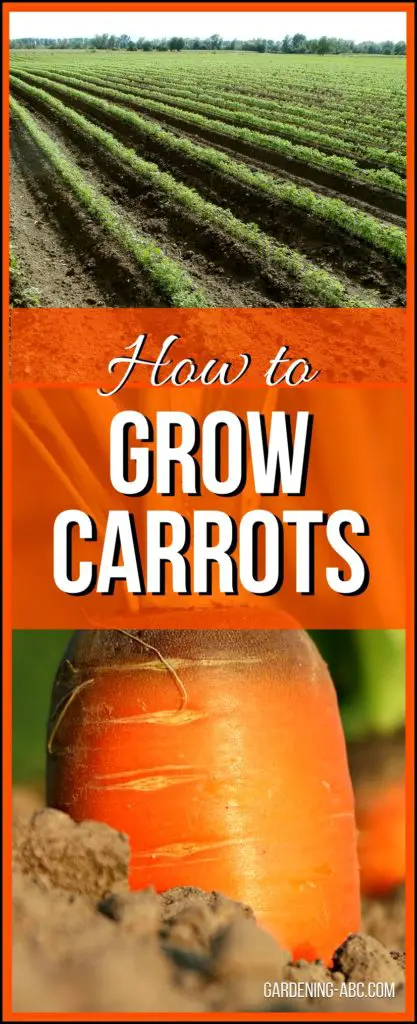We use affiliate links to run our site. When you buy through links on our site, we may earn an affiliate commission, without any added cost to you. Learn more
Carrots are a nutritious addition to any diet. They are an excellent source of Vitamin A and other nutrients that can boost your immune system and help keep your eyes healthy. Interestingly, they are also relatively easy to grow at home.
Now, if you don’t have any idea how to grow carrots at home, this post is for you.
This guide provides some essential tips on how to grow carrots successfully, including how to select the right variety of carrots for your climate, how to prepare your soil, and how to care for your plants.
With a little patience and attention, you can enjoy fresh, home-grown carrots all season long!
How To Grow Carrots
Carrots are actually taproots that have enlarged. They have a very wide and deep root system. It is one of the most popular vegetables and has been grown for centuries.
If you’re interested in growing carrots at home, there are a few things you should know in order to be successful.
Carrot Varieties:
Though we are used to experiencing carrots as orange in color, there are other varieties that can be white, crimson, or even purple in color. But rather than focusing on color, your main concern should be on the root size to suit your soil.
Planting Carrots:
prepare the soil:
If you’re planning on growing carrots, you’ll first need to take some time to prepare the soil.
Carrots are root vegetables, so they need loose, well-drained soil in order to grow properly. You’ll also need to make sure the soil is high in organic matter, as carrots are a heavy feeder.
If you take the time to prepare the soil properly, your carrots will be more likely to grow strong and healthy. With just a little effort upfront, you’ll be rewarded with a bountiful crop of delicious carrots come harvest time.
Carrots prefer fertile, well-drained, deep, sandy soils rich in organic matter for the best growth. Most of the light soil is well suited for growing carrots. If you have heavy soil add some compost to the soil to make it lighter. you can also add coir.
To prepare the soil for growing carrots, start by tilling or spading the area where you plan on planting. If the soil is particularly compacted, you may need to add some sand to loosen it up. Once the area is prepared, add some compost or manure and mix it well.
Use a uniform blend of soil, it should be without any lumps and stones. The presence of lumps or stones can cause the roots to fork. The depth of the soil should be at least twice that of the mature size of the carrot. The ideal pH of the soil should be between 5.5 to 7.0.
Put a sufficient amount of compost or rotting organic matter. Carrots need nutrient-enriched soil. Adding nitrogen can be very crucial to the growth and aesthetics of your carrots. Organic sources such as blood, alfalfa meal, horn meal, etc., can be used.
Also, think about using companion planting and crop rotation techniques. Growing carrots after legumes can eliminate the need for adding extra nitrogen. Avoid hot nitrogen sources like fresh manure and fish fertilizer. They can cause roots to fork.
How To Plant Carrots:
We grow carrots from seeds. Plant them 1⁄4-1⁄2 inch deep in the soil in rows. Once they grow a little bit (3-4 true leaves come out) do a little thinning. Keep a gap of 3-4 inches between plants and 12-18 inches among rows.
Carrots are a cool climate crop. The optimum temperature for growing carrots is 60 to 70 degrees Fahrenheit, so if you live in an area with a warm climate, it’s best to sow your carrots in the winter.
Carrot companion plants:
Carrots also do well with most plants. Rosemary and sage can deter carrot flies. Check companion planting for more details. If you are planning to grow the carrots till it gives you seed, it is necessary that you avoid planting Dill, Coriander, or other plants of the Umbelliferae family.
These plants cause cross-pollination and thus chances of getting the seeds are greatly reduced. Though if you have only planted for the roots and are not concerned about getting the seeds, this might not much of importance to you.
How To Grow Carrots in Containers:
Here is good news for urban gardeners, you can grow carrots in the containers too. Just choose a pot that is at least 12 inches deep (the container should be twice as deep as the size of the mature carrot) and with a good drainage facility.
In case you need more information about container gardening checks out my earlier blog. In this case, try to plant the seeds 1 to 3 inches apart. Cover the seeds with soil and water often (More on watering techniques here). It is always better to try the smaller varieties.

It generally takes 12 to 15 days for seeds to germinate. Once they have emerged, cover them with fine mesh netting. It will help to get air, water, and sunlight, but it keeps pests at bay. Applying mulch can keep the moisture level and also reduce the weed problem.
The growth of the carrot seedling is always slower than the weeds. You can prevent nematodes from harming the plant by applying plenty of compost. These are rich in predatory microorganisms and can prey on nematodes.
Harvesting Carrots:
Carrots can be harvested in less than three months for most of the varieties. You can judge the size of the carrot by looking at the top. Usually, the largest carrots have the darkest and greenest tops. Most are at their prime when about 2.5 cm in diameter at the crown.
It is crucial that you don’t leave your carrots on for too long on the ground. It can make them too long, tough, and sometimes distasteful. Do some watering before harvesting. It will soften the soil and will be easier to take out the carrot.
Cut off the leaves as soon as they are out with some sharp knife. Do not just break the top as it tends to sprout and will shorten its storage life. Leaving them for too long on the ground can attract the carrot fly. Gently wash them with cold water to remove all the dirt and it will also cool them down.
Conclusion:
In conclusion, growing carrots at home is a fun and easy process that anyone can do with a little bit of time and effort. With just a few simple supplies, some patience, and a love for gardening, you can enjoy fresh, delicious carrots right from your own backyard.
So what are you waiting for? Get started today and see the amazing results for yourself!
I hope this post was helpful to you. If you like the information don’t forget to share it with others too.
Recommended reading: How Carrots Won the Trojan War: Curious (but True) Stories of Common Vegetables

Amazon and the Amazon logo are trademarks of Amazon.com, Inc, or its affiliates.
